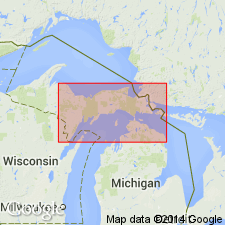
- Usage in publication:
-
- Bony Falls member
- Modifications:
-
- Original reference
- Dominant lithology:
-
- Limestone
- AAPG geologic province:
-
- Michigan basin
Summary:
Pg. 13, 14, 16, 17-22. Bony Falls member of Black River formation. Section at Bony Falls consists of about 40 feet of limestone some of which is argillaceous and some finely crystalline dolomitic; a 2-inch layer of bentonite occurs about middle of section, and this may mark top of Black River. Evidence of subaerial erosion appears at several levels throughout section, and a very obvious disconformity near middle of section may represent a time break of considerable duration. Underlies Chandler Falls member (new) of Trenton formation. Separation of Black River rocks from Trenton above presents difficult problem; rocks of the two formations are commonly distinguished on basis of faunal changes that are not always very significant; deposition was practically continuous at some localities from Black River to Trenton time, and dividing line between the two formations becomes an arbitrary one. Age is Middle Ordovician.
Type locality: at Bony Falls on Escanaba River, in sec. 1, T. 41 N., R. 24 W., Delta Co., northern MI.
Source: US geologic names lexicon (USGS Bull. 1200, p. 429).
For more information, please contact Nancy Stamm, Geologic Names Committee Secretary.
Asterisk (*) indicates published by U.S. Geological Survey authors.
"No current usage" (†) implies that a name has been abandoned or has fallen into disuse. Former usage and, if known, replacement name given in parentheses ( ).
Slash (/) indicates name conflicts with nomenclatural guidelines (CSN, 1933; ACSN, 1961, 1970; NACSN, 1983, 2005, 2021). May be explained within brackets ([ ]).

